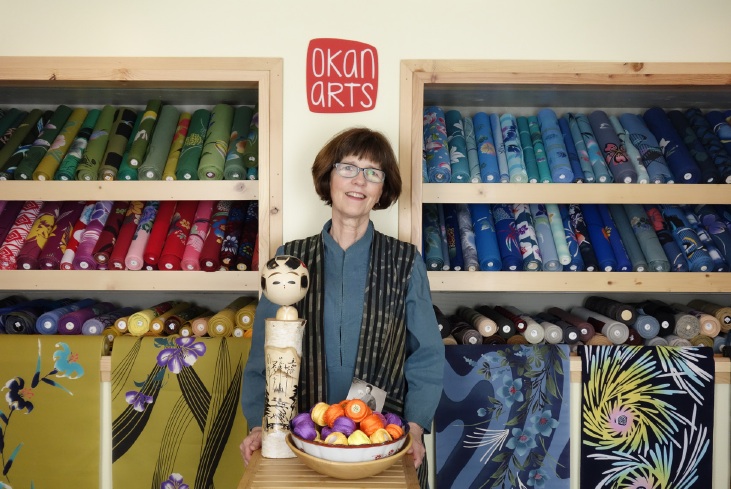Okan Arts imports vintage Japanese yukata cottons for adventuresome quilters.
Okan Arts, owned by textile and natural dye artist Patricia Belyea, is a home-based shop in Seattle, bursting with over 1,000 bolts of vintage Japanese cotton. Hand-dyed by artisans in Japan from 20 to 50 years ago, the cottons radiate luscious colors and a graphic boldness. Simple cousins to the gold-enhanced reproductions of kimono silks typically found in quilt shops, these yukata cottons were made for casual unlined summer kimonos.
“The summers are hot in humid in Japan so breezy, light kimonos made of cotton are perfect. Silk kimonos are typically worn with a few layers underneath and for special social events,” says Belyea.
Not manufactured on a large scale, yukata cottons are chusen dyed in small workshops in a multi-stepped process.
According to Space to Think, the ‘chusen’ dyeing technique was devised in the Meji era (1868-1912). They write: “This technique is as unique as the tenugui designs themselves. Tenugui are dyed by hand, resulting in an inconsistency in the color and pattern of each piece. The design permeates the fabric, so that it can be seen clearly on both sides and as the colour fades with use and age, the cotton acquires its unique soft texture.”
Stencil patterns are cut from specially prepared washi paper. One artisan applies a paste of rice resist through the stencil while a second artisan pours dyes through the cotton. The cotton is then washed multiple times before being hung outside to dry in the sun. Some yukata cottons are dyed two to three times to create complex color combinations.
According to Belyea, one bolt of yukata cotton makes one yukata—a cotton kimono. The bolts, measuring approximately 14” wide and 12 meters long, are rolled on distinctive round cores.
On the cusp of becoming a lost art, yukata cottons produced today cost an exorbitant amount of money. Conversely vintage yukata cottons are considered undesirable to the Japanese, with the closest translation to vintage meaning “used.”
Owner and artisan quilter Patricia Belyea works with over 30 vendors across the island nation—antique warehouses, kimono shops, pickers of estate sales, and more— to procure fabrics for her shop.
“I’m a treasure hunter. When I see something I like, I buy it. I see my inventory as a curated collection,” says Patricia.
ABOUT OKAN ARTS: In 2009, when she had acquired 200 bolts of vintage Japanese yukata cotton, artisan quilter Patricia Belyea launched Okan Arts. In the beginning Patricia set up weekend trunk shows at the front of quilt shops and hosted open houses in her upstairs bedrooms with baskets of fabric displayed across the beds. Patricia opened her brick and mortar shop in the lower level of her home in September 2013, followed by her online shop in January 2015.
Patricia, an industry leader, speaks to quilters around the world about yukata cottons and using them to make out-of-the ordinary quilts. She is past president of Contemporary Quilt Art Association; founder of FiberFest, the spring fundraiser for La Conner Quilt & Textile Museum; and event organizer for JaponTex, a holiday show and sale focused on Japanese textiles. Her book, East-Meets-West Quilts: Tiptoe Into Improv with Japanese-inspired Design, releases in
October 2017 (Abrams NYC).


